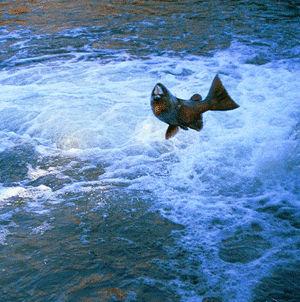This story unfolds at the Kingfisher Interpretive Center” which is situated from Trinity Valley Road north of Lumby or 25km East of Enderby via Highway 97. The centre was holding a “Salmon Take” event on the weekend. It takes place once a year and the public is invited to observe and assist in the catch which provides marine biologists a chance to remove the eggs from the female salmon, then using the male salmon, fertilize the eggs then prepare them for incubation in fish hatchery conditions.
The entire process is part of efforts to restore and rebuild the historical salmon run on the Shuswap River, which includes the creek tributaries in Lumby the most eastern destination of the Chinook salmon in North America.
It’s a great event for families. Participants are provided with life jackets and rubber boots and there is a small boat to bring people to the other side of the river where male and female Chinook are caught in big nets. The females are then cut open to take the eggs, which are poured, into basins, while milt is pressed out of the males and stored in separate bags.
Back at the Interpretive Center children assisted in fertilizing the eggs by mixing eggs from one female with milt from 3 different males to insure a greater success, a little bit of river water was added to help in the mixing process. The eggs are then stored in trays until they hatch, the Chinook fry will then be set free in the Spring for their very long journey downstream to the Pacific Ocean.
The Chinook spend all of their adult lives in the Pacific Ocean until they decide it is finally time to spawn (lay their eggs).
They are driven by a mysterious urge to return to the grounds where they were born so they begin their journey swimming upstream thousands of kilometres. They battle currents and must brave fishermen, birds and other predators. They may leap more than 10 feet over rapids, travelling 15 to 30 km per day in order to reach the quiet inland streams deep in the interior of BC where they were born, Once they arrive they shape their redd which is their underwater nest of loose stones.
Only a small percentage of salmon survive the difficult journey, and if they do, they are bruised, starved and near death. The female lay around 10,000 pea-sized eggs in the redd which is built in shallow water under small gravel; the male gives off the milt which is a milky substance that will fertilize the eggs.
Contrary to the Atlantic salmon, the Pacific salmon dies shortly after spawning. A high rate of fertilization depends on both the water level and the water temperature, also the stream current might move the milt away from the eggs and some eggs might not get fertilized.
After about 45 days little “alevins” see the light, in fact they stay hidden in the stones and feed from a yolk sac in their early stage; 55 days later they finally emerge as “fry” and are ready to leave soon after.
The fry will be on their way to the big city! Their journey downstream to the Pacific Ocean begins down the Shuswap River and eventually to the Fraser River past Vancouver. They have to swim through polluted water and avoid predators, not all of them make it alive but for the ones that do, a great new life awaits them. It’s well worth the risk, they will have plenty of space and an abundance of excellent food in the ocean.
In hatcheries like the one’s found on the Shuswap, a high percentage of the eggs will become adults, while in the wild the rate of success can be very low. Salmon restoration projects such as these are very important to help enhancing the salmon stock in British Columbia, but there are other important ways to help the salmon population by reducing pollution, which leads to habitat degradation and the eventual extinction of a salmon run. Climate change and over fishing can also be a big problem.
If we want to continue having healthy wild salmon in our waterways, then keeping our freshwater streams clean remains an important part of a community goal.
(30)
Discovering the lifecycle of Chinook Salmon
By Celine Dantart - January, 2008
Thanksgiving weekend provided an opportunity to soak up the vibrant fall colours of the Upper Shuswap as well as an opportunity to see new lives coming into this world, thousands of them.
This is a sad yet beautiful story which begins when a group of four year old Chinook salmon end their life cycle as they give birth to a new generation of salmon which will begin their journey back to the Pacific Ocean.



